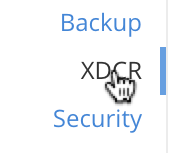Delete a Replication
Deleting an XDCR replication stops the replication of data, and removes the defined replication from Couchbase Server.
Examples on This Page
The examples in the subsections below show how to delete a replication; using the UI, the CLI, and the REST API respectively. As their starting-point, the examples assume the scenario that concluded the page Resume a Replication.
Delete an XDCR Replication with the UI
Proceed as follows:
-
Access Couchbase Web Console. Left-click on the XDCR tab, in the right-hand navigation menu.

This displays the XDCR Replications screen. The lower part of the main panel features an Outgoing Replications panel that currently has the following appearance:

This features information on a single, currently defined replication. In the
statuscolumn, this replication is shown to beReplicating. -
To delete the replication, left-click on the row for the replication. When the
Deletebutton appears, left-click on it:
The following confirmation dialog is now displayed:

Left-click on Delete Replication, to confirm. The Outgoing Replications panel now reappears, showing no replications:

The replication has now been deleted.
Delete an XDCR Replication with the CLI
From the starting-point defined above, in Examples on This Page, use the xdcr-replicate command to delete an XDCR replication as follows.
couchbase-cli xdcr-replicate -c 10.142.180.101 \ -u Administrator \ -p password \ --delete \ --xdcr-replicator=570d0ca2db3b1e128e2fafd362a1bfd4/travel-sample/travel-sample
The value specified for the --xdcr-replicator flag is that retrieved by means of the --list flag, shown in Pause an XDCR Replication with the CLI.
The --delete flag signifies that the replication is to be deleted.
If successful, the command returns the following:
SUCCESS: XDCR replication deleted
Delete an XDCR Replication with the REST API
From the starting-point defined above, in Examples on This Page, use the REST API to delete an XDCR replication as follows.
curl -X DELETE -u Administrator:password \ http://10.142.180.101:8091/controller/cancelXDCR/570d0ca2db3b1e128e2fafd362a1bfd4%2Ftravel-sample%2Ftravel-sample
Note the encoded form of the endpoint, which is required.
This consists of the id, the name of the source bucket, and the name of the target bucket.
These were obtained in Pause an XDCR Replication with the REST API.
If the call is successful, no output is displayed. The replication has been deleted.
For more information, see Deleting a Replication.
Next Steps
Once a replication has been deleted, you may also wish to delete the reference on which it was based. See Delete a Reference.